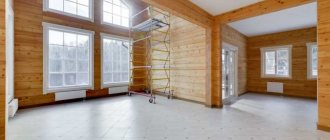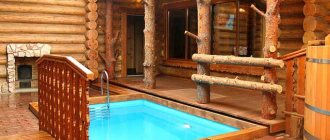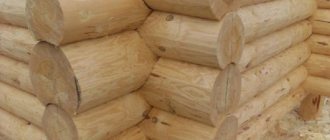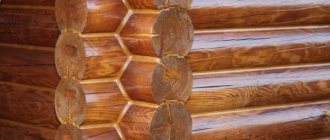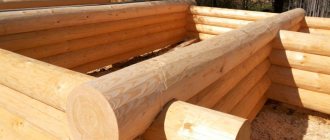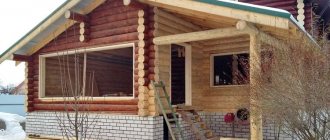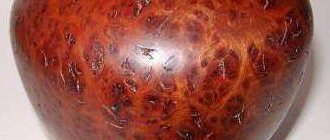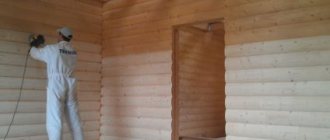Wood is one of the first building materials used by man to build a house. People are attracted to it, first of all, by its naturalness, good heat-saving properties, and unique beauty. We associate a typical rustic log house with an atmosphere of comfort and characteristic warmth.
Nowadays, buildings made from logs processed on rounding machines are very popular. But any master will tell you that wood is a very capricious material. It is afraid of water, but at the same time its pores should not be sealed and “breathing” should not be prevented.
Wood is susceptible to fungus, mold, woodworms, it belongs to the group of highly flammable materials, sometimes the logs of an already built log house can “twist”, they bend and crack. We will tell you how to deal with these problems in this article.
Where to begin
It is advisable to begin caring for wooden structures immediately after assembling the house. Fungi and insects can extremely quickly spoil even high-quality wood, so the task is to prevent them from settling in the wood.
If construction is carried out in spring, autumn or summer, the log must be treated with antiseptics. In winter, this procedure is postponed until the weather warms up.
It is especially important to keep an eye on the ends. Open cuts are channels for the penetration of fungal and mold spores. For processing, it is recommended to use special impregnations or lime.
Why is it necessary to process the ends of logs?
Log cuts need additional protection, because first they crack, darken and change their natural shade to gray.
The reason for this is that the protruding end exposes the softest inner part of the tree.
Even in order to leave the log house in its natural state, the ends will still have to be treated with preparations. This is due to several reasons:
- Increased dampness. Open cuts are vulnerable to external factors. Longitudinal fibers absorb water more actively than transverse fibers, which is why this part of the log quickly becomes damp.
- The appearance of fungus. A large amount of moisture is the cause of mold. It softens the cut line, which is why the open ends rot and then crack.
- Uneven evaporation. Through saw cuts, moisture evaporates faster, this causes deep cracks and deformation of the crowns of the log house.
- The appearance of insects. Rapid evaporation of moisture contributes to the appearance of looseness. Because of this, the interior of the tree becomes vulnerable to temperature changes, and is also easily attacked by woodworms and other insect larvae that destroy it.
Treated ends slow down the evaporation of moisture and make this process more uniform. During shrinkage and shrinkage, the logs crack less, preserving the heat-insulating properties of the structure and its appearance.
What kind of finishing is needed
After the frame shrinks, which lasts from 6 to 12 months, you can begin to finish painting the walls outside. First, sanding is carried out to remove the top layer of wood that has turned gray in the sun, then paint is applied in several layers.
The finish needs to be renewed every 5-15 years, depending on the paint manufacturer's recommendations. It is desirable that the compositions have vapor-permeable properties and allow the wood to “breathe,” because this is what houses made from rounded logs are valued for.
There is no need to paint the walls inside. You can leave the tree in its natural state, preserving its natural qualities. If desired, the logs are sheathed with any decorative and finishing material.
High humidity is a dangerous factor that provokes the formation of mold and mildew. It is not only the external attractiveness of the wooden frame that suffers. Pockets of moisture instantly initiate rotting processes and significantly reduce the life of the house. If you find leaks, fix them as quickly as possible.
What are the treatment compositions?
A variety of compounds are used to process rounded logs. They are divided into five main categories:
2.1 Antiseptics
Perform bioprotection functions. Contained in various chemical compositions. They do not allow fungus, mold and bugs to settle inside the log and infect it. Pre-treatment is done with weak antiseptics. All affected areas are treated with strong concentrates. The most popular brands of the drug are Neomid, Belinka and Tikkurilla. They quickly remove root beetles. Restores the structure of the rounded material.
2.2 Transport antiseptics
Perform temporary protective functions. Apply to logs after trimming and sanding. Manufacturers treat their materials with it before transportation. The drugs protect for six months. During this period, there is guaranteed to be no rot or mold on the logs. Other protective preparations can be applied over transport antiseptics. You can use paints and varnishes. They interact well with each other. The most popular brands are: “Neomid”, “Rogneda” and “OgneBioZashchita”.
2.3 Fire retardants
Contains special flame retardants. These are complex substances. They resist open fire. A rounded log can withstand the effects of fire for several hours in a row. The most famous are “NORTH”.
2.4 Moisture protection compounds
They form a special film on the surface of the material. It closes all the pores of the wood. Looks solid. Has no gaps. The composition prevents moisture from entering the structure of the log house. Protects against rotting. The most famous brands are Pinotex, NEO+ and Biofa.
2.5 Complex materials
These are universal drugs. Provide complete protection from moisture, fire and insects. They cost more. Rogneda is also produced.
About shrinkage
After assembling a wooden house for 6-12 months, excess moisture from the logs evaporates, their volume decreases by 5-11%. All work is suspended for this period.
Deformations are uneven - moisture evaporates most quickly from the outer layers of wood, then from the inner ones. The geometry of the openings changes, so it is not recommended to install doors and windows in the first year after assembly. To prevent damage, the rafter system is secured temporarily or using sliding supports.
Shrinkage of structures will continue for several more years, but at a much slower rate. To prevent damage to windows and doors, casing and frames are fixed in the openings. Their design includes elastic gaskets to compensate for movements.
The resulting cracks are a path for cold penetration and an open gate for fungal spores. After shrinking, they need to be filled with natural or synthetic sealants, acrylic sealant.
Summarizing
Processing round timber is a good way to increase its durability, and its appearance will remain for a long time. In this case, it is necessary to take into account a number of nuances, namely: selecting separate compositions for interior and exterior decoration, properly treating the ends of the logs and sealing cracks. Subject to these conditions, treatment with an antiseptic becomes absolutely harmless to humans and prolongs the life of the log house.
The video in this article describes the external processing of a log house.
Communications in a house made of rounded logs
Wood is a flammable material, so increased safety requirements are imposed on communications, especially electrical ones.
Power cables are laid in the following ways:
- hidden;
- external
Hidden wiring is much more difficult to do. Metal corrugated tubes are used to prevent the fire of wooden structures in the event of a short circuit. They are laid in floors, interfloor ceilings, false walls or frame partitions. Small areas remain visible, which can be decorated in accordance with the design of the premises.
The water supply and sewage systems are isolated as much as possible from the walls of the house, and the pipe joints are carried out to the boiler room and to water collection points.
Open wiring is much easier to install. Non-flammable cable ducts and fittings are used for fastening to log walls. They are produced in different colors, including wood. After installation they remain invisible and do not spoil the interior.
When installing boilers, furnaces and other fire-hazardous equipment, it is important to prevent overheating of wood and sparks from open fire.
Installation of protective devices is mandatory.
Log processing
To process a rounded log, you will need special tools: a brush with (hard) bristles, a sanding machine, a broom, a brush, a sprayer, a roller with synthetic bristles, a small container (for soaking and dipping tools into it).
4.1 Stages of log processing:
- drying (moisture content in the material should be no more than 22%);
- bark grinding (affected areas, bark and dirt are removed);
- dust removal (all areas of the log are processed);
- drug testing (an antiseptic is applied to a test surface);
- body protection (wear gloves and long sleeves);
- good mixing of the composition;
- application (direct sunlight must be avoided; treatment is prohibited in frost; suitable conditions are calm, cloudy and dry weather).
How to protect a wooden house from pests
The most destructive effects on wood are:
- Fungal infections . They appear in the form of spots of various colors, blue, black, mold, dry or wet rot. Antiseptic treatment of wood immediately after cutting and during use helps prevent them. To eliminate signs of the disease that have already appeared, it is recommended to treat the area with special agents that return the color to the wood.
- Insects . Complex antiseptic impregnations allow you to avoid infection by bark beetles, shawls or borers. Treatments should be repeated at least once every 5 years. If larvae or bugs do appear, you can get rid of them by injecting disinfectant solutions, fumigating with chemicals, and repeated treatments with fumigators.
- Rodents . Laying out poisoned baits, using repellents, and keeping a cat in the house helps in the fight. It is important to block the entry routes for pests into your home. To do this, at the construction stage, the lower joints are covered with a fine-mesh mesh, and the cracks are carefully sealed.
Regular maintenance will help keep your home safe and comfortable. The sooner you start activities, the longer wooden structures will last.
Protecting logs from cracking
To prevent cracking of a log, you need to protect its main less vulnerable place - the ends. To do this, you can use the excellent product Tor Plus from Neomid. It will prevent the logs from cracking when drying and will reduce their linear deformation. In addition, it will prevent the ends from becoming waterlogged and rotting. After application, a thin and elastic coating is formed on the surface, which has good water resistance and vapor permeability. Thor Plus does not lead to changes in the structure of the log. Manufacturers release impregnation to the market immediately in a ready-to-use form.
Features of the antiseptic “LuxDecor Plus”
The product is an acrylic water-soluble antiseptic with increased resistance to aggressive weather conditions - such as rain, wind, snow. The period of effective protection of cylinders from pests, mold, fungi and rot is 3 years.
During the construction and finishing of turnkey wooden structures, you can use this product for both external and internal processing. This is possible due to the absence of toxic elements in the antiseptic composition.
The gel-like consistency ensures ease of application; even when treating ceilings, the mixture does not flow or drip. When applied in 2 layers, a matte silky appearance can be achieved.
Internal covering for a log house - finishing and protection
How to cover the inside of a log house, and is it necessary to do it at all?
Manufacturers of logs and timber often claim that wooden houses do not require interior finishing at all, but this is not entirely true. Wood really looks very beautiful, and covering it with any materials is not the best solution, but it needs protection from various damaging factors, so it is impossible to do without treatment at all. Its purpose is not only a decorative, but also a protective coating, which, moreover, will preserve the natural texture of the wood.
HAVE QUESTIONS? WE WILL HELP!
If you have any questions
about our projects, technologies and capabilities,
call right now on multi-channel numbers:
8 (495) 649-89-90.
Send us a request
PYZHOV VYACHESLAV Construction Director
Kadrova Ekaterina Architect
"Mokke Foressa" - a product for reliable processing
The chemical composition is based on alkyd resins, due to which resistance to ultraviolet solar radiation increases significantly.
Three-layer application provides a slight shine. Treated logs acquire the appearance of expensive wood for up to 7 years.
Microscopic particles of wax included in this impregnation make it possible to achieve the formation of a moisture-resistant film on the internal and external surfaces of a rounded log.
When choosing a product, you should pay attention to the duration of the impregnation, its composition and application methods.
If you need wood pigmentation, you can look at the catalog with tinting samples. But you need to understand that the final color can differ significantly on different species and therefore text coloring of the logs in inconspicuous places directly on the construction site is recommended.
